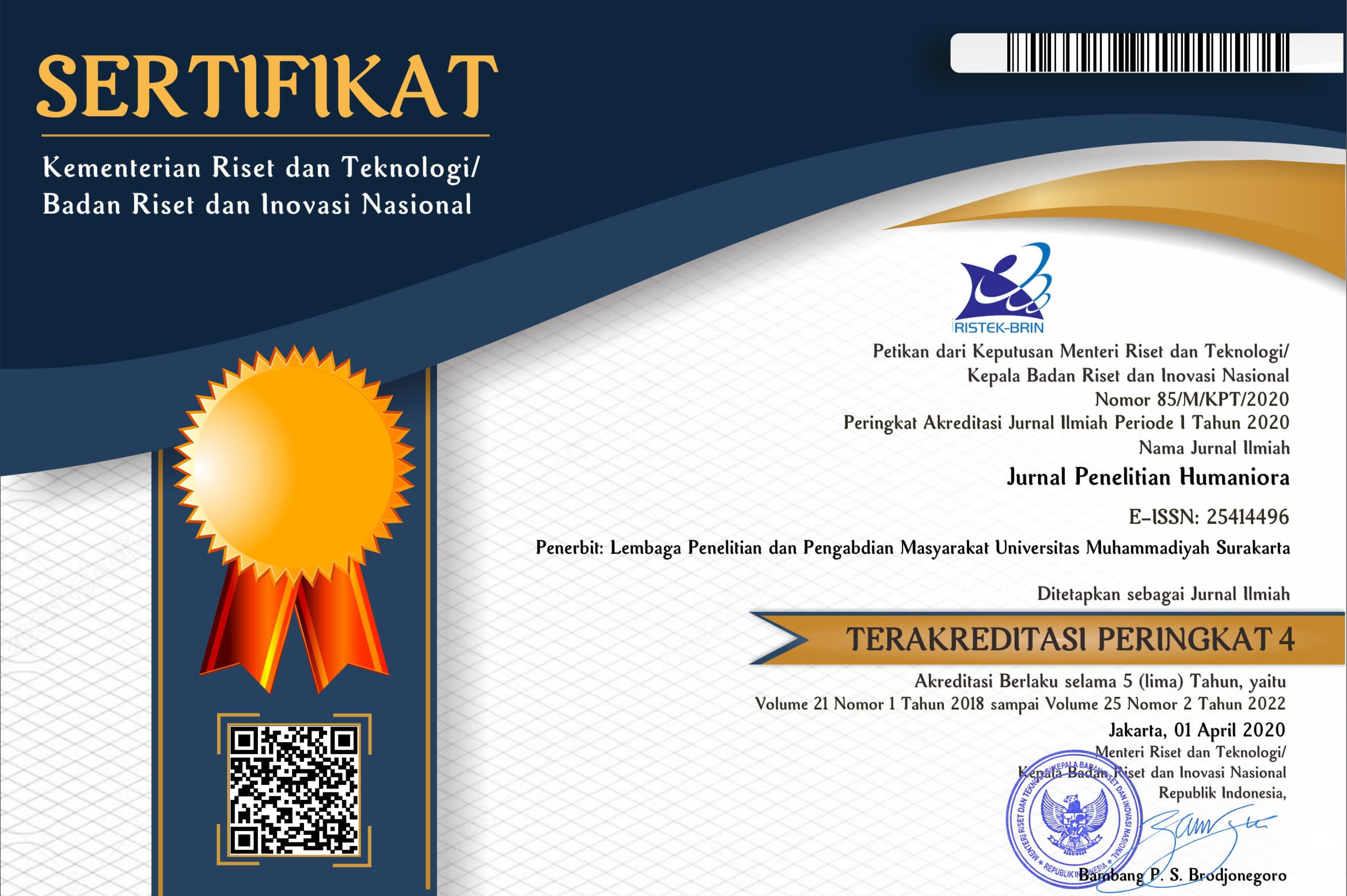EXPLORING COLLOCATIONS IN BAHASA INGGRIS TEXTBOOK: A CORPUS STUDY
Raden Indrajid Lukman Sarjono(1), Ayuni Kabobu Heda(2), Barli Bram(3*)(1) Sanata Dharma University, Yogyakarta
(2) Sanata Dharma University, Yogyakarta
(3) Sanata Dharma University, Yogyakarta
(*) Corresponding Author
Abstract
This paper explored the types of collocations used in an English textbook entitled Bahasa Inggris (SMA/MA/SMK/MAK, Kelas X, Semester 1). The primary source of data was the textbook, entitled Bahasa Inggris, which was published by the Indonesian government for the first-year or class 10 students of senior high schools (SMA/MA/SMK/MAK). This study was a corpus analysis. The researchers utilized AntCont 3.5.8 to extract and discover the required data and then explored the types of collocations used in the Bahasa Inggris textbook. The results showed that the textbook comprised of Grammatical G1 (1807), Grammatical G3 (178), Grammatical G4 (1770), Grammatical G5 (1), Lexical L1 (594), Lexical L3 (125), Lexical L5 (21), and Lexical L6 (1). Grammatical G1 collocation was the most frequent type in the textbook. The results indicated that it would be beneficial for English teachers to provide collocation materials for the students to accommodate their writing and speaking skills.
Keywords
Full Text:
PDFReferences
Alfiandita, O. L., & Ardi, P. (2020). Collocations in the English LKS books for senior high school students. IJELTAL (Indonesian Journal of English Language Teaching and Applied Linguistics), 4(2), 213-227.
Anthony, L. (2004). AntConc: A learner and classroom friendly, multi-platform corpus analysis toolkit. proceedings of IWLeL, 7-13.
Anthony, L. (2005, July). AntConc: design and development of a freeware corpus analysis toolkit for the technical writing classroom. In IPCC 2005. Proceedings. International Professional Communication Conference, 2005. (pp. 729-737).
Barr, R. (1988). Conditions influencing content taught in nine fourth-grade mathematics classrooms. Elementary School Journal, 88, 387-4
Benson, T., Akella, A., & Maltz, D. A. (2010, November). Network traffic characteristics of data centers in the wild. In Proceedings of the 10th ACM SIGCOMM conference on Internet measurement (pp. 267-280).
Corver, N., & van Riemsdijk, H. (Eds.). (2013). Semi-lexical categories: The function of content words and the content of function words (Vol. 59). Walter de Gruyter.
Freeman, D. J., & Schmidt, W. H. (1982, March). Textbooks: Their messages and their effects. Paper presented at the Annual Meeting of the American Educational Research Association, New York
Hasko, V. (2012). Qualitative corpus analysis. The encyclopedia of applied linguistics.
Haspelmath, M. (2004). On directionality in language change with particular reference to grammaticalization. Typological Studies in Language, 59, 17-44.
Henriksen, B. (2013). Research on L2 learners’ collocational competence and development: A progress report. In C. Berdel, B. Laufer, & C. Lindqvist (Eds.), L2 vocabulary acquisition, knowledge and use: New perspectives on assessment and corpus analysis. (pp. 29–56). Eurosla.
Jaén, M. M. (2007). A corpus-driven design of a test for assessing the ESL collocational competence of university students. International Journal of English Studies, 7(2), 127-148.
Koteyko, N. (2014). Corpus linguistics and the study of meaning in discourse. Linguistics Journal, 2.
Koya, T. (2004b). Collocation research based on corpora collected from secondary school textbooks in Japan and in the UK. Dialogue, 3, 7–18.
Lewis, M. (2000). Language in the lexical approach. In M. Lewis (Ed.), Teaching collocation: Further developments in the lexical approach (pp. 126–154). Language Teaching Publication.
Martyńska, M. (2004). Do English language learners know collocations? Investigationes Linguisticae, 11, 1-12.
McCutcheon, G. (1982, March). Textbook use in a central Ohio elementary school. Paper presented at The Annual Meeting of the American Educational Research Association. (ERIC Document Reproduction Service No. ED 216 96
McEnery, T. (81). Wilson.(2001). Corpus linguistics. Edinburgh University Press
Nation, I. S. P. (2002). Learning vocabulary in another language (3rd ed.). Cambridge University Press.
Richards, J. C. (2014). The ELT textbook: In International perspectives on materials in ELT (pp. 19-36). Palgrave Macmillan.
Nesselhauf, N., & Tschichold, C. (2002). Collocations in CALL: An investigation of vocabulary-building software for EFL. Computer Assisted Language Learning, 15(3), 251–279.
Roohani, A. (2011). Collocations in high school and pre-university English textbooks versus new interchange book series. The Journal of Asia TEFL, 8(3), 55–81.
Talmage, H. (1972). The textbook as arbiter of curriculum and instruction. Elementary School Journal, 73, 20
Weninger, C., & Kiss, T. (2013). Culture in English as a foreign language (EFL) textbooks: A semiotic approach. TESOL Quarterly, 47(4), 694-716.
Widyati, U., Furaidah, & Rohmah, Z. (2014). Bahasa Inggris: Untuk SMA/MA/SMK/MAN Kelas X Semester 1. Pusat Kurikulum dan Perbukuan, Kementerian Pendidikan dan Kebudayaan.
Woolard, G. (2000). Collocation: Encouraging learner independence. In M. Lewis (Ed.), Teaching Collocation: Further Developments in the Lexical Approach (pp. 28–46). Language Teaching Publication.
Yule, G. (2017). The study of language. (6th ed.). Cambridge University Press.
Article Metrics
Abstract view(s): 630 time(s)PDF: 871 time(s)
Refbacks
- There are currently no refbacks.











